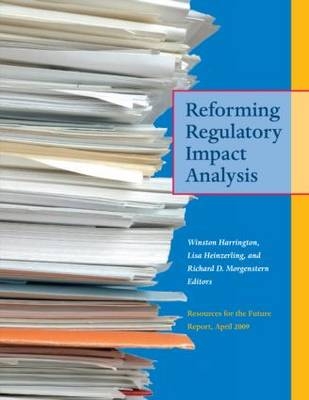
Reforming Regulatory Impact Analysis
Resources for the Future Press (RFF Press) (Verlag)
978-1-933115-75-7 (ISBN)
Over the past decades, considerable debate has emerged surrounding the use of cost-benefit analysis (CBA) to analyze and make recommendations for environmental and safety regulations. Critics argue that CBA forces values on unquantifiable factors, that it does not adequately measure benefits across generations, and that it is not adaptable in situations of uncertainty. Proponents, on the other hand, believe that a well-done CBA provides useful, albeit imperfect, information to policymakers precisely because of the standard metrics that are applied across the analysis. Largely absent from the debate have been practical questions about how the use of CBA could be improved. Relying on the assumption that CBA will remain an important component in the regulatory process, this new work from Resources for the Future brings together experts representing both sides of the debate to analyze the use of CBA in three key case studies: the Clean Air Interstate Rule, the Clean Air Mercury Rule, and the Cooling Water Intake Structure Rule (Phase II). Each of the case studies is accompanied by critiques from both an opponent and a proponent of CBA and includes consideration of complementary analyses that could have been employed. The work's editors - two CBA supporters and one critic - conclude the report by offering concrete recommendations for improving the use of CBA, focusing on five areas: technical quality of the analyses, relevance to the agency decision-making process, transparency of the analyses, treatment of new scientific findings, and balance in both the analyses and associated processes, including the treatment of distributional consequences.
Winston Harrington is a senior fellow at Resources for the Future. Lisa Heinzerling is a professor of law at Georgetown University Law Center. She is currently on a leave of absence, serving as senior climate policy counsel at the Environmental Protection Agency. Richard D. Morgenstern is a senior fellow at Resources for the Future.
Preface
1. Controversies Surrounding Regulatory Impact Analysis
2. The Clean Air Interstate Rule
3. The Technocratic and Democratic Functions of the CAIR Regulatory Analysis
4. The CAIR RIA: Advocacy Dressed Up as Policy Analysis 56
5. The Clean Air Mercury Rule
6. The Mathematics of Mercury
7. The CAMR: An Economist‘s Perspective
8. The Cooling Water Intake Structures Rule
9. Improving the CWIS Rule Regulatory Analysis: What Does an Economist Want?
10. Fish Tales
11. What We Learned
Contributors
Index
| Erscheint lt. Verlag | 1.7.2009 |
|---|---|
| Verlagsort | Washington |
| Sprache | englisch |
| Maße | 210 x 280 mm |
| Gewicht | 544 g |
| Themenwelt | Recht / Steuern ► Allgemeines / Lexika |
| Recht / Steuern ► EU / Internationales Recht | |
| Sozialwissenschaften ► Politik / Verwaltung ► Politische Theorie | |
| Technik ► Umwelttechnik / Biotechnologie | |
| Wirtschaft ► Volkswirtschaftslehre | |
| ISBN-10 | 1-933115-75-0 / 1933115750 |
| ISBN-13 | 978-1-933115-75-7 / 9781933115757 |
| Zustand | Neuware |
| Haben Sie eine Frage zum Produkt? |
aus dem Bereich


